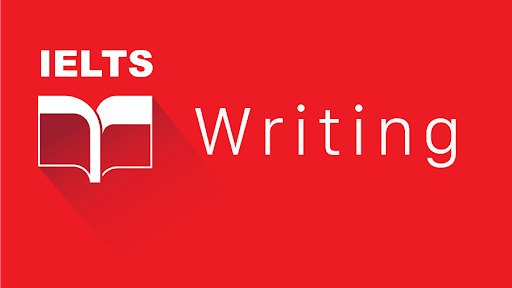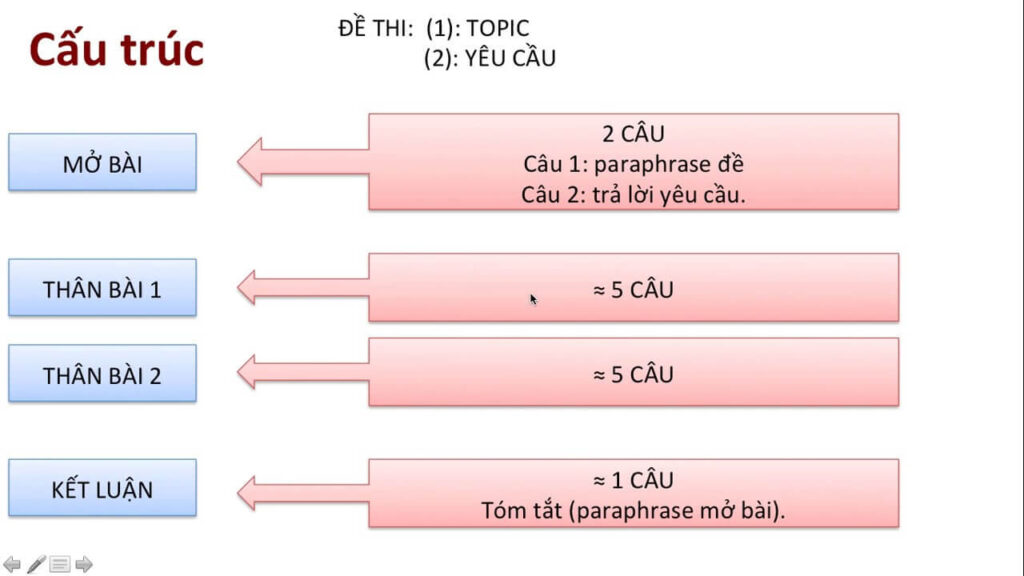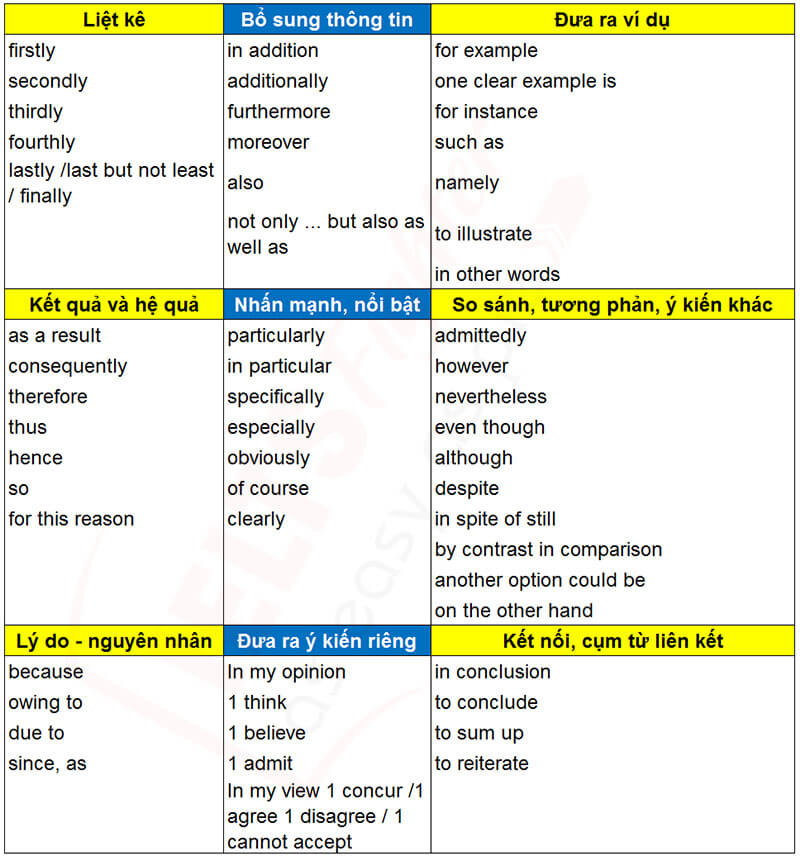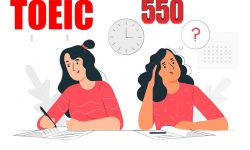Trong các kỳ thi IELTS thì phần Writing Task 2 có thể được xem như khó khằn và lấy điểm nhất trong khi nó chiếm tận 60% tổng điểm phần thi viết. Để có được điểm cao trong phần này ngoài ngữ pháp, từ vựng và cách hành văn ra thì phương thức và cấu trúc bài viết chiếm yếu tố rất quan trọng.

Vì lý do đó, tailieuielts.com sẽ hướng dẫn cách viết IELTS Writing Task 2 và giúp bạn học nắm rõ các dạng câu hỏi và cách viết bài chi tiết.
Nội dung chính
1. Tổng quan IELTS Writing Task 2
IELTS Writing Task 2 đòi hỏi thí sinh dự thi viết một bài essay tối thiểu 250 từ nói lên ý kiến, quan điểm của mình về vấn đề nêu ra trong đề.
IELTS Writing Task 2 được chấm điểm theo bốn tiêu chí sau:
- Task Response (25%): đánh giá khả năng giải quyết các vấn đề nêu ra trong đề bao gồm cả luận điểm, luận cứ và ví dụ hỗ trợ lập luận của người thi.
- Coherence & Cohesion (25%): đánh giá khả năng xây dựng bài viết và khả năng liên kết các ý chặt chẽ, chính xác.
- Lexical Resources (25%): đánh giá vốn từ vựng phong phú và chính xác.
- Grammatical range and accuracy (25%): đánh giá khả năng sử dụng đa dạng, chính xác cấu trúc ngữ pháp tiếng Anh.
Các dạng câu hỏi thường gặp trong bài thi IELTS Writing bao gồm:
- Argumentative/Opinion Essay
- Discussion
- Cause & Solution
- Two – part question
2. Cách viết IELTS Writing Task 2
2.1. Cấu trúc chung

Khi viết bài IELTS Writing Task 2 hãy cố gắng theo một khung nhất định ngay lúc mở đầu. Điều này sẽ giúp bạn không phải dàn quá nhiều thời gian xử lý đề, ngoài ra cũng tạo tư duy logic ngay từ đầu.
Một bài essay thường có cấu trúc như sau:
- Phần Introduction (mở bài) gồm có hai câu:
Câu một: bạn có thể paraphrase lại câu chủ đề của đề bài hoặc theo phương thức gián tiếp rồi dẫn nhập vào chủ đề với mở đầu tiên của phần mở bài thường là các cụm “People have different views about …” hoặc “People have differing views about”.
Câu thứ 2: bạn cần đưa ra câu trả lời cho câu hỏi đề bài một cách đơn giản, rõ ràng, trực tiếp trong tâm câu hỏi, và thường được sử dụng bằng cụm “In my opinion” hoặc “In my view”. - Phần Body (thân bài) bao gồm hai đoạn với độ dài mỗi đoạn 4 đến 6 câu. Trong đó sẽ bao gồm một câu luận điểm, chủ đề chính và 4 đến 5 câu giải thích bổ trợ cho câu chủ đề, luận điểm chính. Lưu ý trong phần này luôn có giải thích và ví dụ.
- Phần Conclusion (kết bài): Để xác nhận lại quan điểm, chủ kiến và nhấn mạnh câu trả lời cho câu hỏi của đề bài. Thường bắt đầu bằng các cụm từ “In conclusion” hoặc “To conclude”, …
Xem thêm các bài viết dưới đây:
- Ebook Barron’s writing for IELTS – Tải Trọn bộ Barron’s IELTS PDF + Audio miễn phí
- Tải sách Trọn bộ Intensive IELTS Listening, Reading, Speaking, Writing miễn phí
- Tải sách Academic writing for ielts by Sam McCarter miễn phí
Ví dụ:
Topic: It is generally believed that some people are born with certain talents, for instance for sport or music, and others are not. However, it is sometimes claimed that any child can be taught to become a good sports person or musician. Discuss both these views and give your own opinion
Introduction: The relative importance of natural talent and training is a frequent topic of discussion when people try to explain different levels of ability in, for example, sport, art or music.
Body:
Paragraph 1: Obviously, education systems are based on the belief that all children can effectively be taught to acquire different skills, including those associated with sport, art or music. So, from our own school experience, we can find plenty of evidence to support the view that a child can acquire these skills with continued teaching and guided practice. However, some people believe that innate talent is what differentiates a person who has been trained to play a sport or an instrument, from those who become good players. In other words, there is more to the skill than a learned technique, and this extra talent cannot be taught, no matter how good the teacher or how frequently a child practices.
Paragraph 2: I personally think that some people do have talents that are probably inherited via their genes. Such talents can give individuals a facility for certain skills that allow them to excel, while more hard-working students never manage to reach a comparable level. But, as with all questions of nature versus nurture, they are not mutually exclusive. Good musicians or artists and exceptional sports stars have probably succeeded because of both good training and natural talent. Without the natural talent, continuous training would be neither attractive nor productive, and without the training, the child would not learn how to exploit and develop their talent.
Conclusion: In conclusion, I agree that any child can be taught particular skills, but to be really good in areas such as music, art or sport, then some natural talent is required.
2.2. Dạng 1: Argumentative/Opinion Essay
Dạng bài “Argumentative essay” là một trong những loại topic thường xuất hiện trong đề thi IELTS Writing task 2. Loại bài này đồi hỏi các bạn đưa ra ý kiến, quan điểm cá nhân về một vấn đề được nêu ra trong đề; ngoai ra, các luận điểm và ý bổ trợ để bảo vệ cho quan điểm cần phải có. Dạng bài này thường xuấ hiện với những câu hỏi/yêu cầu như sau:
- Do you agree or disagree?
- To what extend do you agree or disagree?
Ví dụ:
- An American film actor once said, “Tomorrow is important and precious”. Some
people think individuals and society should pay more attention to the future than to the present. Do you agree or disagree? - Scientists and the news media are presenting ever more evidence of climate change.
Governments cannot be expected to solve this problem. It is the responsibility of
individuals to change their lifestyle to prevent further damage. What are your views?
Để trả lời thì các bạn thường có ba các sau:
- Đồng ý hoàn toàn (Strongly agree)
- Không đồng ý hoàn toàn (Strongly disagree)
- Đồng ý/ Không đồng ý một phần (Partly agree/disagree)
Cách viết:
Trong dạng này, bài essay sẽ có viết như dạng essay chung nhưng phần thân bài sẽ được triển khai khác nhau phụ thuộc vào quan điểm của bạn.
- Phần 1: Introduction
Gồm hai câu với các ý sau:
Bước 1: Diễn đạt, giới hạn chủ đề và xác nhận ý trong đề bài
Bước 2: Đưa ra quan điểm cá nhân (Đồng ý/ Không đồng ý/ Trung lập)

- Phần 2: Body
Gồm 2 đoạn, phụ thuộc vào quan điểm bạn chọn mà 2 đoạn này sẽ khai triển theo những cách khác nhau:
Đoạn 1 (Main paragraph 1) Đoạn 2 (Main paragraph 2)
- Đồng ý hoàn toàn: Lần lược đưa lý do giải thích cho quan điểm đồng ý.
- Không đồng ý toàn toàn: Lần lược đưa lý do giải thích cho quan điểm không đồng ý.
- Trung lập: Lần lượt đưa luận điểm hỗ trợ cho cả hai mặt vấn đề vì sao đồng ý và không đồng ý.
Ngoài ra, các bạn cũng có thể triển khai phần thân bài của bạn theo một cách khác khi bạn đồng ý hay không đồng ý với nhận định:
- Đoạn 1: Giải thích vì sao bạn chấp nhận 1 mặt của nhận định được đưa ra
- Đoạn 2: Đưa ra các lý lẽ để khẳng định rằng bạn đồng ý/ không đồng ý với nhận định đó
Ở phần thân bài các bạn cần đưa ra luận điểm rõ ràng và dùng một số phương pháp để triển khai luận điểm như:
- Đưa ví dụ
- Đưa ra giải thích
- Đưa ra kết quả
- Phần 3. Conclusion
Kết bài bạn cần làm hai việc sau:
- Khẳng định quan điểm của bản thân (Đồng ý hoàn toàn/ Không đồng ý hoàn toàn/ Trung lập)
- Tóm lược ý chính đã để củng cố quan điểm đó.
Xem thêm bài viết sau:
- Tải Full IELTS Recent Actual Tests – Reading, Listening, Writing & Speaking Full PDF + Audio
- Tải trọn bộ sách Intensive IELTS Speaking, Listening, Speaking, Reading [PDF]
- Get IELTS writing Academic Band 9 sample PDF – Tải trọn bộ
2.3. Dạng 2: Discussion (Disscuss both views)
Đây là dạng bài sẽ đưa ra hai quan điểm về một vấn đề và đòi hỏi bạn nêu ý kiến về 2 quan điểm đó. Bạn cần phân tích chi tiết cả hai ý kiến và nếu như cần nêu ý kiến cá nhân thì bạn có thể chèn vào phần mở hay kết bài của mình mà không cần thêm đoạn.
Cách viết dạng này khá giống với loại Argumentative/Opinion Essay, chỉ khác ở chỗ khi mở đầu đoạn thân bài thứ hai thì hay được nối băn “On the one hand”.
Ví dụ:
“Some people believe that studying at university or college is the best route to a successful career, while others believe that it is better to get a job straight after school. Discuss both views and give your opinion.”
Introduction
When they finish school, teenagers face the dilemma of whether to get a job or continue their education. While there are some benefits to getting a job straight after school, I would argue that it is better to go to college or university.
Body
The option to start work straight after school is attractive for several reasons. Many young people want to start earning money as soon as possible. In this way, they can become independent, and they will be able to afford their own house or start a family. In terms of their career, young people who decide to find work, rather than continue their studies, may progress more quickly. They will have the chance to gain real experience and learn practical skills related to their chosen profession. This may lead to promotions and a successful career.
On the other hand, I believe that it is more beneficial for students to continue their studies. Firstly, academic qualifications are required in many professions. For example, it is impossible to become a doctor, teacher or lawyer without having the relevant degree. As a result, university graduates have access to more and better job opportunities, and they tend to earn higher salaries than those with fewer qualifications. Secondly, the job market is becoming increasingly competitive, and sometimes there are hundreds of applicants for one position in a company. Young people who do not have qualifications from a university or college will not be able to compete.
Conclusion
For the reasons mentioned above, it seems to me that students are more likely to be successful in their careers if they continue their studies beyond school level.
2.4. Dạng 3: Cause & Solution

Phần Introduction sẽ trả lời gián tiếp câu hỏi từ đề bài (nguyên nhân/vấn đề + giải pháp)
Phần Body được chia làm hai đoạn, đoạn 1 đề cập đến nguyên nhân/vấn đề, đoạn 2 nói về giải pháp để giải quyết các vấn đề đã được đưa ra ở đoạn 1.
Ví dụ:
More and more people now own cars. What are the problems associated with an increase in the usage of private cars? How can these problems be solved?
Chúng ta có thể phân biệt loại đề này khi xuất hiện các từ sai:
Problems – reasons – happend
Solutions – What measures can be taken to resolve this problem…
Xem thêm bài viết sau:
- Hướng dẫn chi tiết cách viết Cause and Effect essay – IELTS Writing Task 2
- TOP 29 chủ đề thường gặp trong IELTS Writing task 2
- Tải full Trọn bộ IELTS Advantage skills: Listening, Reading, Speaking and Writing(PDF)
2.5. Dạng 4: Two – part question
- Dạng bài này đề sẽ đưa ra hai câu hỏi yêu cầu người viết phải trả lời.
- Cấu trúc bài viết tương đối đơn giản, thân bài bao gồm 2 đoạn, mỗi đoạn được trả lời cho một câu hỏi.
- Ví dụ:
“Many people prefer to watch foreign films rather than locally produced films. Why could this be? Should governments give more financial support to local film industries?”
Introduction
It is true that foreign films are more popular in many countries than domestically produced films. There could be several reasons why this is the case, and I believe that governments should promote local film-making by subsidising the industry. (tóm tắt chủ đề và câu hỏi đề bài).
Body
Paragraph 1: There are various reasons why many people find foreign films more enjoyable than the films produced in their own countries. Firstly, the established film industries in certain countries have huge budgets for action, special effects and to shoot scenes in spectacular locations. Hollywood blockbusters like ‘Avatar’ or the James Bond films are examples of such productions, and their global appeal is undeniable. Another reason why these big-budget films are so successful is that they often star the most famous actors and actresses, and they are made by the most accomplished producers and directors. The poor quality, low-budget filmmaking in many countries suffers in comparison. (trả lời câu hỏi thứ nhất).
Paragraph 2: In my view, governments should support local film industries financially. In every country, there may be talented amateur film-makers who just need to be given the opportunity to prove themselves. To compete with big-budget productions from overseas, these people need money to pay for film crews, actors and a host of other costs related to producing high-quality films. If governments did help with these costs, they would see an increase in employment in the film industry, income from film sales, and perhaps even a rise in tourist numbers. New Zealand, for example, has seen an increase in tourism related to the ‘Lord of the Rings’ films, which were partly funded by government subsidies. (trả lời câu hỏi thứ 2)
Conclusion
In conclusion, I believe that increased financial support could help to raise the quality of locally made films and allow them to compete with the foreign productions that currently dominate the market.
3. Chú ý
- Khi viết bài IELTS Writing Task 2, bạn cân chú ý phân bổ ý kiến, quan điểm, dẫn chứng sao cho đầy đủ bổ sung cho ý chính trong bài. Chú ý không cần viết quá nhiều chỉ cần viết đủ và nhiều hơn một xí tránh mất quá nhiều thời gian. Viết câu nào chắc chắn ngữ pháp câu đó.
- Ngoài ra, bổ sung vốn từ vựng là cần thiết để có điểm cao cho bài IELTS Writing Task 2.
- Dưới đây là một số từ nối đảm bảo và nâng cao tính mạch lạc cho bài viết mà bạn có thể dùng:

Trên đây là bài viết hướng dẫn cách viết IELTS Writing Task 2 – Các dạng câu hỏi và cách viết bài chi tiết. Qua bài viết này, tailieuielts.com hy vọng bạn học có thể hiểu, ôn luyện và thi hiệu quả hơn trong phần IELTS Writing Task 2.









Bình luận